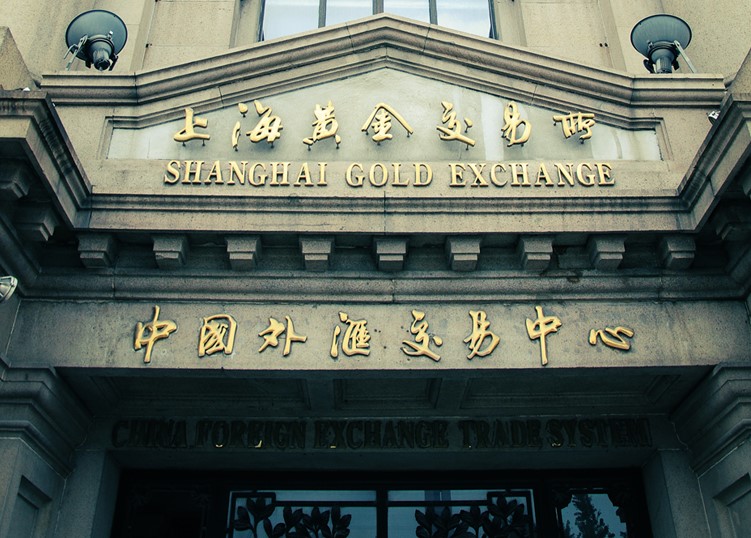In major eastern financial news, the Shanghai Gold Exchange could soon be delivering specific products to overseas partner warehouses to aid in internationalizing the futures trade and settlement with partners.
That was the headline item in an 18-item report revealed by Lu Lei, deputy governor of the People’s Bank of China, during a briefing on Wednesday afternoon. Other items included enhanced cross-border financial services, reinsurance coverage for Belt and Road Initiative projects, and high-level preparations for an international financial asset trading platform to help increase international participation in China’s financial systems.
Of the three major precious metal exchanges, the Shanghai Metals Exchange is the third-largest. However, China is not only one of the world’s largest producers of gold, but also one of the world’s largest importers, and the PBoC, the state’s central bank, is one of the world’s biggest customers.
Entitled the “Action Plan for Further Enhancing Cross-border Financial Service Facilitation in the Shanghai International Financial Center,” the report mentioned enhancing the function of key financial platforms in allocating global resources, and supporting the Shanghai Gold Exchange and other institutions in conducting product authorization cooperation with overseas exchanges, expanding the application of RMB benchmark prices in international mainstream markets, and exploring the internationalization of specific product deliveries at the Shanghai Gold Exchange and the establishment of overseas delivery warehouses.
Though the report didn’t say where such warehouses might be or which products would be delivered, the Shanghai Metals Exchange primarily deals in non-ferrous metals like gold, silver, copper, aluminum, etc.
Most of the country’s trade continues to be benchmarked against international prices, such as those set on the London Metals Exchange (LME).
Last October, in an insider feature story at Reuters, the English media outlet claimed that as the world’s largest consumer of all metals, China was investigating how it could leverage the Shanghai Futures Exchange (SHFE) to influence the prices of those metals. According to information gained from a variety of high-level insiders at the SHFE, it would involve exactly what Lu and the PBoC just announced: international warehousing for overseas deliveries.
“Only through opening up can we draw in foreign investors, participate in the process of SHFE’s price establishment, therefore enhance price influence,” Wang Fenghai, general manager at SHFE, was quoted as telling state media by Reuters at the time.
LME, the world’s largest metals exchange, uses hundreds of partner warehouses around the world to store thousands of tons of copper, aluminum, precious metals, and other materials. By replicating this, which the SHFE announced would be pursued in 2020 with copper, and now again with what is presumed to be precious metals, Shanghai is expanding its ability to satisfy international deliveries to the point that a new set of SHFE benchmark prices could be reliably worked into futures contracts.
“SHFE benchmarks would eliminate the need for Chinese firms to link their physical contracts to LME prices and create a need for foreigners to trade on SHFE to influence reference prices in their contracts, shifting market sway from the west to China,” Reuters reported.

Belt tightening
In the broader financial realm, total cross-border trade on the Shanghai stock and futures exchanges scratched the undercarriage of 30 trillion RMB, or $4.1 trillion in 2024, a whopping 30% increase year-over-year and an “important milestone” as Lu called it.
“In the context of profound changes in the external environment, enhancing the convenience of cross-border financial services has become even more significant,” Lu said, according to SCMP.
What may also make this “even more significant” is that the announcement of the precious metals warehousing comes just two weeks after President Trump’s “Liberation Day” tariff regime. Dozens of countries are supposed to have already come forward for trade negotiations in the wake of the sweeping reciprocal tariffs that were eventually paused. It’s presumed that many of these negotiations will include stricter controls on markets and industries the US is hoping to exclude China from.
In many ways, the double threat of 245% tariffs with the US and that bargaining with Washington may increasingly mean mutual exclusivity with Beijing for third-party nations really justifies much of China’s financial strategy over the last 25 years. While still maintaining the role as the workshop of the world, the diversity of that workshop has expanded dramatically to include enormous production in some of the most complex and high-value goods on the market.
This diversification should go some way in helping protect Chinese markets from trade war policies from the US. Additionally, China’s perseverance with its fabled One Belt One Road Initiative has given it another realm to help internationalize and expand into as it looks to increase global involvement with the SHFE.
It doesn’t take a fund manager to imagine a world in which SHFE vaults and warehouses are built in Belt and Road partner countries, at which any organization or government can pay SHFE benchmarks in RMB to receive metals deliveries along the network of Belt and Road infrastructure projects. Talk about a brave new world.
Such vaults and warehouses would also allow countries to store gold somewhere other than the US Federal Reserve Bank of New York, which holds more global, that is, non-US, state-owned gold reserves than any other financial institution worldwide. Having already shattered the status quo of global trade, the idea that President Trump might impose a gold embargo on a country who keeps their gold in the US is not overly imaginative, and in fact was done to Venezuela 5 years ago.
Gold prices recently passed $3,300 per ounce and continue to make new all-time record highs riding the tailwinds from Liberation Day, exciting gold traders and propelling many gold mining stocks to break out of a long period when stock prices didn’t didn’t rise commensurately with gold prices. WaL
We Humbly Ask For Your Support—Follow the link here to see all the ways, monetary and non-monetary.
PICTURED ABOVE: The Shanghai Gold Exchange Building. PC: John Pain, CC 2.0. via Flickr


